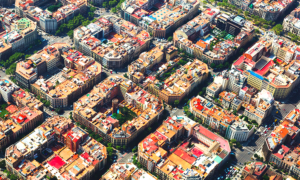Barcelona has a total municipal area of 10,140 hectares, with an estimated population of 1,620,809 inhabitants (47.3% male, 52.7% female), resulting in an average density of 15,992 people per Km2 (2017).
Population
The urban population has remained predominantly stable in the last 10 years, with an annual growth rate almost equal to zero, fluctuating between a negative of -0,65% (2007) and a positive of 0,26% (2016). Over the same period, birth rate and mortality rate have stayed almost unchanged from a yearly average of 8,32 and 9,32 per thousand people respectively; whereas net migration has also continued unvaried, with a positive of 20 immigrants per thousand people yearly (85.172 immigrants in 2017). As of 2016, in-flow movements remain driven mainly by economic reasons, with 40% of newcomers arriving from Spain and 60% from abroad. In the latter group, Italians, Pakistani, Chinese and French represent the four broadest international communities in the city.
Within this context, Barcelona is also subjected to significant demographic fluctuations both between day and night, and between week days and weekends. The first is the extent to which residents from the metropolitan region or broader Catalonia commute daily for work/study/personal reasons (257,605 in-commuters and 226,111 out-commuters, at the county scale). The second relates to the increasing popularity of Barcelona as a destination for both national and international tourism. Over 9 million people visited the city in 2016 alone, mainly between May and October and over weekends, confirming a steadily increasing trend.
Household
According to 2011 municipal surveys, 99% of the population is grouped into 684,079 household units, with an average household size of 2.33. Within this picture, almost 59% of households correspond to a family unit – whether with or without dependents – and 29% to single persons, 64% of which are female householders. The remaining portion includes non-family households (students or other types of flat share).


